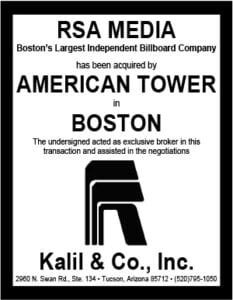
By Michael F Wright
The November 10 oral argument in City of Austin v. Reagan National Advertising provided limited but interesting insights into how the justices line up in the Court’s first billboard case since its fractured 1981 decision in Metromedia, Inc. v. City of San Diego.
The issue in City of Austin boils down to whether the onsite-offsite distinction is content based and subject to strict scrutiny under the Court’s 2015 decision in Reed v. Town of Gilbert.
The City’s lawyer Michael Dreeben and Assistant U.S. Solicitor General Benjamin Snyder made two major arguments. First, they said the category of offsite speech is an “empty vessel” so broad that it has no inherent content. A regulation that selectively limits offsite messages thus is content neutral. Second, they said that applying strict scrutiny to a limitation on offsite signs would blow up the Highway Beautification Act, sign ordinances across the country, SEC regulations, and a host of other laws. It would also conflict with Supreme Court precedent upholding rules limiting solicitation.
Three justices – Sotomayor, Kagan, and Breyer – agreed, although Justices Kagan and Breyer (the latter with some hilarity) questioned whether the City or the Solicitor General had a coherent theory of where to draw the line between speech categories that do and don’t threaten First Amendment values. On the other side, Justice Thomas pressed the City’s Mr. Dreeben about whether under the Austin ordinance wasn’t content-based if (as Dreeben admitted) it allowed a sign advertising Franklin’s Barbecue at Franklin’s restaurant but not elsewhere.
Justices Barrett, Kavanaugh, and Gorsuch asked Mr. Snyder what I think were the most important questions: Couldn’t the City further safety and aesthetics directly by regulating the size, brightness, and spacing rather than by reference to a sign’s message? (In my view, the honest answer is of course they can.)
Four of the justices, Roberts, Gorsuch, Alito, and Kavanaugh, seem torn between their view that the distinction between onsite and offsite messages is content and reluctance to adopt a rule that may steamroll sign regulations all over the country. Justice Kavanaugh was the most open: “The tension for me. . . is. . . between this history and common practice [of using onsite-offsite], which means a lot to me, but I don’t want to water down what it means to be content-based.”
Chief Justice Roberts seemed skeptical of both sides. He asked Dreeben if an ordinance that banned signs within 25 yards of the highway except for signs that advertised businesses in the City of Austin would be content based. When Dreeben (of course) said yes, the Chief Justice asked if offsite messages weren’t just as much a “subject” that triggered strict scrutiny under Reed as the Austin locations in his hypothetical.
On the other hand, the Chief Justice was having none of Reagan lawyer Kannon Shanmugam’s argument that holding the onsite-offsite distinction subject to strict scrutiny would not blow up the HBA. “I think it would be diluting our content-based test for you to say that [the HBA] can possibly satisfy it.”
A recurrent theme was Justice Alito’s Reed concurrence, in which he described the onsite-offsite distinction as content neutral. Did he mean that the distinction between onsite and offsite messages is content neutral, or was he referring to a distinction based on a sign’s location regardless of message?
Justice Alito posed questions about signs that were off-premises in “the conventional sense of the term. They are not in front of a building.” He again talked about Reagan’s signs’ being off-premises, “[i]n the conventional sense, not in the – the peculiar sense in which Austin defines the term.” Justice Alito’s “conventional sense” seems to mean location regardless of message. If so, it suggests that onsite-offsite in his Reed concurrence meant location, not messages.
But like his colleagues, Justice Alito wanted to know “what we would be buying if we bought the, if you have to read it, it’s content-based argument.” He wanted to know the effect on, for example, federal food and other regulations.
Justice Gorsuch seemed to lean toward holding the onsite-offsite distinction content based. He first confirmed with Mr. Dreeben that the City’s argument was “a matter of generality,” i.e., that the category of offsite signs was so broad that it had no inherent content and thus was not content based. He then asked Mr. Snyder if Austin’s ordinance favored majoritarian speech, or at least the messages of those who own property in Austin. Justice Gorsuch suggested that such a bias allows government to put its finger on the First Amendment scales.
Yet Justice Gorsuch also expressed interest in how many jurisdictions have based their sign regulations on the onsite-offsite distinction.
So, the lineup looks like Sotomayor, Kagan, and Breyer joining in an opinion that holds onsite-offsite not subject to strict scrutiny and decides for Austin. Justices Thomas and Barrett seem inclined to find the ordinance content based. But whether they will apply strict scrutiny or intermediate scrutiny under the commercial speech doctrine is not clear. The other four justices’ votes are too close to call.
Discussion of the case law took a back seat. Justice Kavanaugh quoted an amicus brief that complained that “experts have spent decades wandering in the intellectual wilderness” of Metromedia. “So I think we owe some clarity.” Metromedia is confusing mainly because it produced no majority opinion. To extract binding precedent from Metromedia, you have to apply the murky, much-maligned Marks rule. Marks says that the holding in a fractured decision is the position taken by the Justices who “concurred in the judgment[] on the narrowest grounds.” But neither side even cited Marks in their briefs.
Another point not mentioned at argument (nor in the briefs I read) is that if the Marks plurality opinion is authoritative, section V of that opinion says that San Diego’s sign ordinance – which like Austin’s distinguished between onsite and offsite signs – was content based.
Finally, Justice Kavanaugh said, “this decision is going to affect every state and local official around America.” And don’t expect a fractured decision this time.
[wpforms id=”9787″]
Paid Advertisement

















